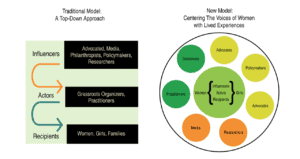Differentiating Features
A New Collaborative Model
The traditional collaborative model involves a top-down approach for designing strategies and potential solutions. As shown in the diagram above, traditional influencers are advocates, media, philanthropists, and policymakers who inform how the actors (practitioners, grassroots organizers) should provide services to those impacted by the targeted issues. In this model, the individuals who are most impacted by the issues are passive recipients of services and programs and have no opportunity to inform the strategies that directly impact their lives. It is only through an equitable distribution of power– to those most impacted by economic injustices – that harmful, sexist, and racist economic practices can stop and our collective economy can thrive.
GWI will build upon WESI’s model of collaboration where women experiencing economic insecurity take a central role in defining the problem and advising on solutions to improve economic security for all women. In this new model, women with lived experiences are influencers, actors, and decision-makers working alongside funders, advocates, organizers, researchers, and practitioners.

Asset-Building Framework
GWI will build the capacity of organizations from different sectors to shift from an anti-poverty framework that focuses on remedying deficiencies and shorter-term solutions to an asset-building framework that focuses on evidence-based practices and methods for increasing longer term wealth and assets. GWI and its partners will build on women’s strengths by increasing capability, access, and opportunity.

Intersectional Lens
Evidence from practice and research has shown that individuals with the lowest amount of wealth are Black and Brown women due to systemic racist and sexist policies and practices. GWI will disaggregate data to see patterns that can hide in larger aggregated data and unpack the complexities of race and gender to ensure that practices and resources are targeted to where they are most needed.
The Multiplier Effect
One funder or one organization alone cannot deliver optimal results. A more effective approach to complex social problems is to involve women with lived experience and partners from different sectors as part of solutions. This is necessary to achieve long lasting systemic change.
The Gender Wealth Institute will build upon WESI’s approach and methodology where collective impact can be reached via collaboration and its network of 80+ active partners representing 70+ organizations that span from local to regional to national. As shown in the pie chart below, partners represent the for-profit, non-profit, philanthropic, and public sectors, as well as women with lived experience of economic insecurity.

Click here to see list of GWI’s current partners.
GWI Reach
GWI will have national reach through leveraging its existing national partners who include:
Bill and Melinda Gates Foundation (www.gatesfoundation.org) & Robert Wood Johnson Foundation (www.rwjf.org):
Provide funding, technical support and a national learning community on narrative change work.
Closing the Women’s Wealth Gap, a national coalition of more than 500 partners (womenswealthgap.org):
Provides research reports, data in real time, a national learning community on closing the gender wealth gap, and opportunities to disseminate GWI learnings, promising practices, and impact across the country.
Working for Women, which enables businesses to be a force for social good and elevate women in the workforce (www.workingforwomen.org) & ZS, a global professional services firm (www.zs.com):
Together, they are providing pro bono support to help to build a data repository and an advocacy framework that connects data points to stories of women with lived experiences.

